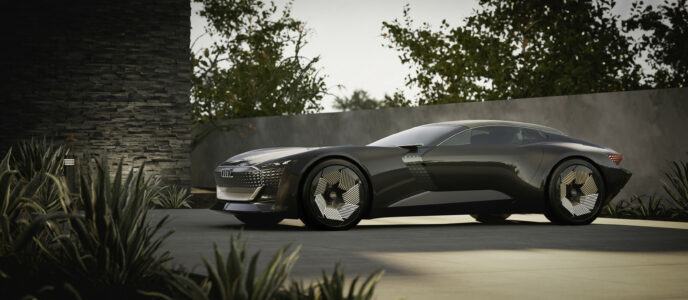
Audi has revealed the first member of a new family of concept vehicles, a spectacular electric roadster called the Skysphere concept due out in 2022.
The two-door convertible is geared for autonomous driving, and includes a revolutionary redesign of the interior, and a seamless digital ecosystem.
It offers a grand touring experience and a sports experience using a variable wheelbase.
Electric motors and a sophisticated mechanism with body and frame components that slide into one another make it possible to vary the wheelbase itself and the exterior length of the car by 250mm. At the same time, the vehicle’s ground clearance is adjusted by 10mm to enhance comfort and driving dynamics, also reducing aerodynamic drag.
With the touch of button, the driver can choose their own driving experience.
Either they pilot their 4.94m-long e-roadster themselves in Sports mode with a reduced wheelbase, while the rear-wheel steering ensures the vehicle remains extremely agile despite its dimensions.
Or they can choose to be chauffeured around in a 5.19m GT in the autonomous Grand Touring driving mode while enjoying the sky and scenery, maximum legroom, and the integrated digital ecosystem.
In the latter mode, the steering wheel and pedals move into an invisible area while the Audi Skysphere automatically keeps an eye on the road and traffic with its sensor system and drives the occupants safely to their destination.
Passengers can share their experience on the road with friends via social media, with images of the interior and the surrounding area.
The vehicle also takes care of everyday tasks that go beyond the ride itself. For example, the autonomous Audi Skysphere concept picks up its passengers with information about their current destination and independently handles parking and charging.
The concept will be unveiled on its home turf in California on August 13 as part of Monterey Car Week as the concept car was conceived and designed at the Audi Design Studio in Malibu near the Pacific Coast Highway.
Studio manager Gael Buzyn and his team used the 1930s Horch 853 roadster as inspiration for the new g model.
The Skysphere includes a spacious trunk filled with two golf bags specially designed for the concept car.
Its battery is expected to exceed 80kWh, providing more than 500km range (WLTP). Battery modules are mainly behind the cabin, which suits the vehicle’s centre of gravity and agility, while more are between the seats in the centre tunnel.
The drive system provides 465kW of power and 750Nm of torque gets from zero to 100km/h in four seconds.
It weighs about 1800kg, the weight distribution of around 60% on the powered rear axle results in ample traction and acceleration.
Steering is via a steer-by-wire system that controls both the front and the rear wheels. Because the system is not mechanically connected to the front axle, the driver can select different steering ratios and steering settings – all at the touch of a button. This allows the steering to be adjusted from extremely direct to comfortable, but also from high self-aligning forces to minimal self-aligning forces, for example when parking.
The rear-axle steering and adaptive wheelbase also contribute to the car’s small turning radius.
Audi’s latest adaptive air suspension has been implemented in the concept car and features three independent air chambers to provide a comfortable base suspension. Individual chambers can be deactivated for a more sporty ride with fast acceleration.
When coasting, the individual wheels are selectively raised or lowered to compensate for road unevenness and undulations.
Mounted on aerodynamically styled 23-inch alloy rims, the 285/30 tyres balance suitability for long-distance trips thanks to minimal rolling resistance and a sporty, active driving style with high longitudinal and lateral acceleration.
Large touch monitor surfaces – 1415mm wide, 180mm high – on the dashboard and in the upper area of the centre console are used to operate the vehicle and infotainment systems.
In Grand Touring mode, this can be used to display content from the Internet, video conferences, or streamed movies. Small touch panels in the doors operate the air conditioning.








